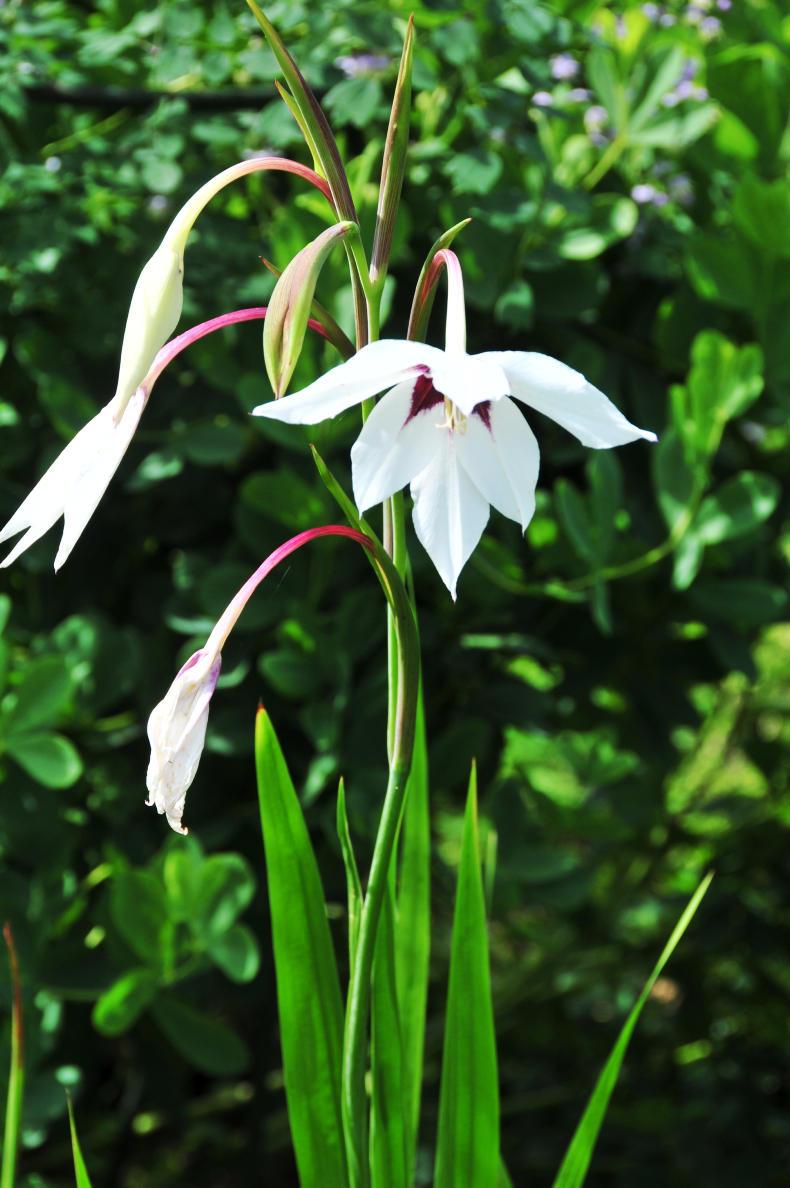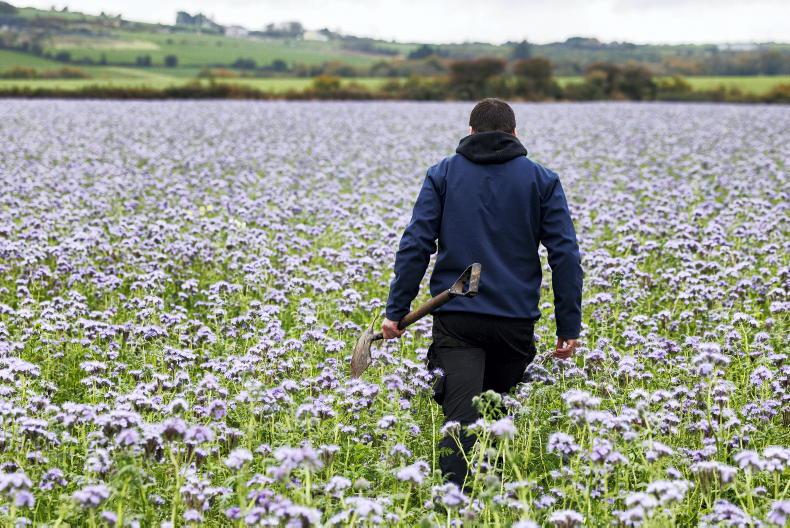The common name of peacock orchid is more than a bit confusing – the plant has nothing to do with either peacocks or orchids.
In a flight of fancy, it might be possible to see a resemblance in the flower to the shape of an open orchid, and even more imagination might see the nodding head and arched neck of a peacock. However, it is a catchy name.
The flower is also known as Abyssinian gladiolus, a name that links it with its region of origin and its links with gladiolus. Abyssinia is an old name for Ethiopia and the plant is also called Ethiopian gladiolus, and it is native to east Africa, from Ethiopia to Mozambique.
The botanical name has varied from time to time. It used to be called Acidanthera, related to gladiolus, part of the iris family. However, it is now not considered different enough from gladiolus to have a separate name and it is currently called Gladiolus callianthus. The second part of the name means beautiful flower, which it most certainly is.
The pure white flower has six pointed petals, three held like a hood arching over the rest of the flower, the other three dropping away.
Each flower is attractively marked with a diamond shape of deep maroon at the throat. The flowers are famously scented with a rich sweet scent, reminiscent of orange-blossom, and the scent releases best on a warm day in the evening. It is worth growing for the scent alone. But the flowers have great beauty too, especially the manner in which they are carried on a gracefully arching flower tube, which usually has a light flush of the maroon seen in the throat of the flower.
The flowers are carried, up to eight or 10 of them, on a slender flower spike, very like that of the ordinary gladiolus but lighter and more elegant.
All gladiolus kinds are a bit tender but this species is even more so. Like other gladiolus, it is a summer bulb, a flat corm actually. The corms are planted out in late April or early May and produce a fan of pointed sword-shaped leaves, the flower spike emerging in late summer and early autumn.
In some years, when autumn comes early and cold or wet, this lovely flower can run out of growing season. This does not happen in the warmer counties where it can flower into October, but it can occur in cold inland counties that can have chilly nights, even frost, in September.
It is possible to grow the corms in a large pot, starting them in a greenhouse in March, to bring earlier flowers. Growing them in a pot also makes it easy to move the corms into a dry place in winter, ideally protected against frost.
Like all gladiolus, natives of dry lands with hot summers, the peacock orchid must be grown in very well-drained soil, ideally with some coarse sand mixed in, and a layer of the sand spread under the corms to keep the base of them dry. They like good fertile soil and some well-rotted compost can be dug in. Watering and liquid feeding can boost growth, and are essential for pot-grown plants.
Position this flower in full sunshine. Grown in a pot, it can be placed in a border, or on a paved area, even just on the point of flowering.
Wetness and cold can take a toll on this flower and the corms can die off or fail to flower after the first time. Some people treat them as an annual flower but this seems wasteful, perhaps okay for once. More satisfaction is to be gained by getting it to flower again. CL
Rampant rose blackspot
Blackspot disease of roses has been rampant this summer and many rose bushes in gardens are practically defoliated at this stage, with a few flowers looking faintly ridiculous on near-bare stems. Some bushes are optimistically pushing out a few new leaves. There are other diseases – rust, mildew and leaf spot – that have caused damage too.
Disease-resistant varieties can be grown instead, though none is disease-proof. Rose breeders have been making disease-resistance a priority, and some roses have a fair degree of resistance, including the Austen roses, the Carpet series, rugosa types and some hybrid musks. If roses were affected this year, they will be affected again next year and must be sprayed regularly, if not replaced.
Trees, shrubs and roses
Trees and shrubs have made good growth this year. In parts of the country with light soil, check for water shortage as the roots may not have grown out of the pot shape. Continue preparations for autumn and winter tree planting, making sure to control perennial weeds before planting.
Flowers
Spring bulbs are in the shops and it is a good time to decide on new locations for bulbs. Bedding and container annuals will last longer if given some liquid feeding now – they still have up to two months flowering to go but will fade long before that without some feeding and regular watering.
Fruit, vegetables and herbs
Sweetcorn can be picked as soon as the kernels turn milky when squeezed. Early apple varieties came in ahead of usual this year and should be used as they do not keep. Get rid of all old crops when they are finished and do not let weeds get away to reduce problems in following years.
Lawns
Lawns have been looking well and have been growing strongly. Little needs to be done except to keep the grass mown. Autumn lawn fertiliser could be applied if the grass is slow through lack of nutrients. It is still a bit early for moss control but it could be carried out in the coming weeks.
Greenhouse and House plants
Keep picking greenhouse tomatoes, peppers and cucumbers as soon as they come ready, otherwise cropping tails off quickly. Stop feeding most greenhouse plants now because they will have enough in the pot to keep them going and they are better going into winter a little ‘harder’.










SHARING OPTIONS